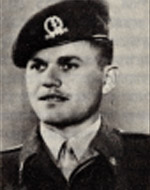Bogayevich, David
Son of-Arieh-Zvi and Sarah. He was born on February 5, 1936 in Lodz, Poland. When World War II broke out (and David was three years old), the father escaped from the Germans. In 1940, the family left for Lvov, where the father was. The following year, when the war broke out between Russia and Germany, the family continued to travel to other parts of the country. The family suffered from a lack of clothing and food, and after the father’s death, the burden of the family fell on the mother. After the war, after suffering from disease and hunger, the refugees began returning to Poland with the help of public institutions. The mother went to a refugee camp in Germany and David, together with his sister, joined a group of children who set out on their way to Israel. The group came to Indersdorf, a former convent where many children from the Dror youth movement were gathered. David was then ten years old and there he began his studies for the first time (until then he could not read or write). He was in the group of children who received the guidance and care of educators and emissaries from Israel; Among them was Moshe Schechter (who fell in the battle for Husan in 1957.) After their stay there, they moved to France and joined the “Exodus.” During the months of the sea shake, Haifa and David met again with the sister who traveled On a different ship, they immigrated to Israel as a family in 1948. David, as a member of the “Aliyat Hanoar” group, was a member of the “Oren” group of the children’s group there. He was very attached to Beit Hashita and saw it as his home, and after the first two years in Beit Hashita, David Med He was recruited to the IDF in August 1954 and took a course in the IDF, and noted that his service in the army had a positive effect on his personality, and he fell during his duty on the 19th of Marcheshvan 5704 (November 4, 1955) And was brought to rest at the military cemetery in Haifa, where Kibbutz Beit Hashita published a booklet called “Aranim Shnagdu” in memory of Moshe and his friend Moshe. His memory and the memory of his friend were also included in the booklet Tevet 5717 of “Pages” (information of the Department of Immigrant Absorption of Children and Youth published by the Jewish Agency in Jerusalem).
